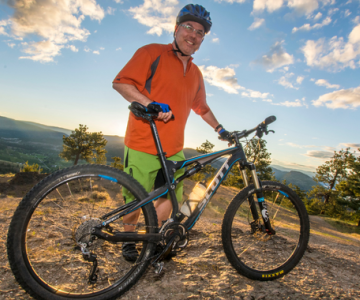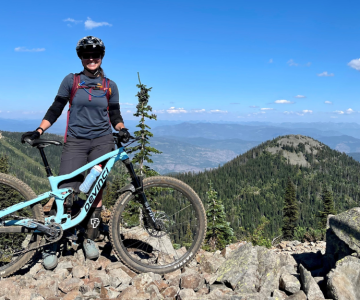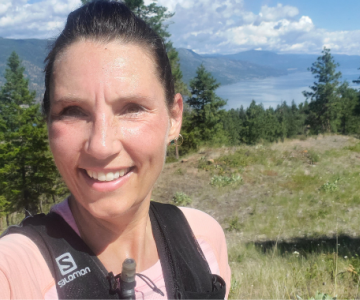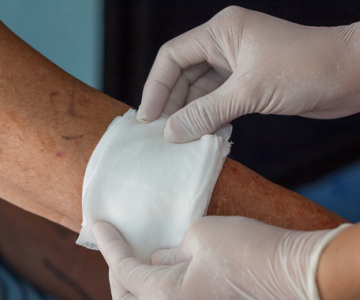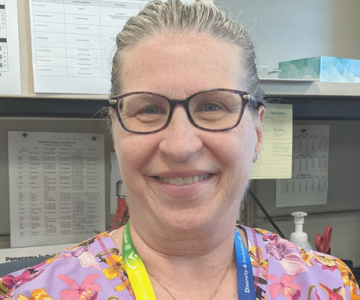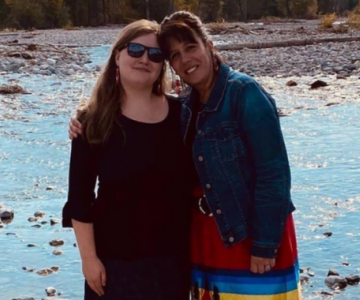Breadcrumb
Explore Stories
Health & Wellness
A whole new language has been introduced to our daily conversations, thanks to the COVID-19 pandemic. Words and phrases like variants, mRNA vaccines, and rapid antigen testing have become commonplace as we have learned about coronavirus and how to keep ourselves safe and healthy from the disease.
And now a new set of words has entered the local lingo – monovalent and bivalent vaccines. So what exactly do those words mean?
We asked Kristiina Smith, an immunization specialist with Interior Health, to help us better understand these terms, which most people will start hearing more about as invitations for COVID-19 booster shots begin going out this fall.
“Simply put, a monovalent COVID-19 vaccine targets a single strain of the virus, while a bivalent vaccine targets two strains,” Kristiina says. “The booster shots you’ve had previously have been monovalent – targeting the original COVID-19 virus. This fall, the booster is a bivalent vaccine, formulated to attack both the original virus and the Omicron BA.1 virus which we’re seeing more of in our communities.”
For this fall’s boosters, Health Canada has approved the Moderna Spikevax Bivalent COVID-19 vaccine for use as a booster dose for people 18 years of age and older. This is the first COVID-19 vaccine with two strains available in Canada, and is expected to provide better protection against the Omicron variant that is making people sick in the community.
Kristiina says vaccines that target more than one variant of virus are not new. In fact, your annual flu shot is usually a trivalent or quadrivalent vaccination – targeting the three or four strains of influenza that scientists predict will be most prevalent in our communities during respiratory illness season.
“Because viruses change over time, it’s important that we continue to get our booster shots for COVID-19 and for the flu when they become available,” she says. “That’s how we’ve been able to resume our day-to-day lives, like attending sporting events, school events like graduation and music concerts. It’s all about establishing immunity for your community.”
Learn more:
For information about COVID-19 vaccinations for those over age 11, visit our COVID-19 Immunization Clinics page. For vaccination information for children, visit the COVID-19 Children Under 12 Vaccines page. Register for vaccinations in the provincial Get Vaccinated system.
Community & Culture
Name: Chris Foley (he/him/his)Job Title: Workplace Health & Safety AdvisorYears of Service: 20Worksite: Commerce CourtCommunity: PentictonAncestral Territory: SyilxFavourite Quote: “Life should not be a journey to the grave with the intention of arriving safely in a pretty and well-preserved body, but rather to skid in broadside in a cloud of smoke, thoroughly used up, totally worn out, and loudly proclaiming ‘Wow! What a ride!’” — Hunter S. Thompson
Workplace Health & Safety advisor Chris Foley is originally from Howell, Michigan. After marrying his Canadian wife, Jacquie, he moved to B.C. in 1993. They’ve lived in Summerland for the past 28 years, where they raised four amazing children.
Chris has a fun-loving nature, and he’s always looking forward to the next adventure. When it comes to his job, Chris is hard-working and serious about helping others.
“I started 20 years ago as a home support worker and care aide. Then, I worked as a rehab assistant because of the desire to help patients. Since I got the opportunity to join the Workplace Health & Safety (WHS) team, I’ve kept sight of the patient care piece, but focus more so on staff safety and well-being nowadays.”
Health & Wellness
Immunization and vaccines are important throughout your life. Vaccines are products that produce immunity to a specific disease. Immunization (or vaccination) protects people from disease by introducing a vaccine into the body that triggers an immune response.
Read on to find out five important things you should know about immunizations and vaccines, and visit our Immunization and vaccines page for more information.
Health & Wellness
There’s little I love more than cruising down a sweet single track on my mountain bike. Add my dog and some pals into the mix and you have a recipe for my perfect day! Even though I’m a confident rider and have the skills and experience to tackle most of what the trails throw at me, things can still go sideways, and unfortunately brain injury is a real risk of the sport I love.
Earlier this spring, my season was off to a great start. I was feeling fit and confident, and even tackled a bike everyday challenge where I mountain biked for 24 days straight before a knee injury from a running accident put me out for a few days. But I recovered quickly and was back on the bike in a matter of days.
However, in mid-May I had a crash that showed me first hand the possible consequences of the sport I am so passionate about.
It was a lovely spring evening on Knox Mountain in Kelowna, on a trail I’ve done many times with a group of supportive pals, where I took a crash that caused me to experience my first concussion and started me on a new journey of recovery, learning, and rebuilding my confidence to get back on my bike.
Here’s my story of brain injury and recovery, and the lessons I learned from the experience.
Community & Culture
Name: Brandy Martin (she/her/hers)Job Title: Central Functions Rehabilitation AssistantYears of Service: 25Worksite: Vernon Jubilee HospitalCommunity: VernonAncestral Territory: SyilxAdvice to live by: You have to have a work-life balance.
Brandy Martin, a central functions rehabilitation assistant, was born in Medicine Hat, Alta. She moved to Vernon, B.C., in 1987 and has been working at Interior Health for more than two decades.
“As a health-care worker for the past 25 years, and a JOHSC [Joint Occupational Health & Safety Committee] co-chair for the past year, I have come to really appreciate working with others that have a good work ethic and are willing to work collaboratively together to achieve the same goals.”
Health & Wellness
A person can bleed to death from an injury in as little as five minutes. That means every second counts when it comes to stopping uncontrolled bleeding, and anyone – a friend, family member or even a bystander – can help save someone’s life.
Think of it as you would with basic first aid, CPR or the Heimlich Manoeuvre – knowing the steps to getting bleeding under control fast can significantly increase a person’s odds of survival.
Traumatic accidents can happen anywhere – in the kitchen or garage, in a motor vehicle, or during outdoor recreational activities such as cycling or hiking. No matter how safe you are trying to be, everyone is at risk of potential injury, which can result in bleeding from extremities such as the neck, groin, armpits, chest and abdomen.
That’s where an initiative such as Stop The Bleed comes in.
In a nutshell, Stop the Bleed trains people how to stop a person from bleeding to death. It was initiated by the American College of Surgeons in 2015 after the active shooter event at Sandy Hook Elementary School in Newtown, CT. Stop the Bleed has been adopted by Trauma Services BC to help teach basic life-saving skills to health-care professionals and members of the public.
“Bystanders or loved ones are often in the best position to provide early assistance to an injured person who is bleeding. Having the skills, confidence and basic equipment to stop someone’s bleeding early can mean the difference between life and death,” says Kyla Gowenlock, Interior Health’s network director for Trauma Services. “I encourage everyone to take the Stop The Bleed course and stock their car or backpack with the basic equipment. Anyone can be trained to save a life.”
Community & Culture
Name: Tanya Chmilar (she/her/hers)Job Title: Registered Nurse/Registered Psychiatric NurseYears of Service: 25Worksite: Community Health Services CentreCommunity: KelownaAncestral Territory: Syilx OkanaganAdvice to live by: Have fun and do your best. Maintain a work-life balance.
Tanya Chmilar lives her motto every day — both at work and in her personal life: Have fun and do your best. After earning her Psychiatric Nursing Diploma in 1985, and her General Nursing Diploma in 1988, Tanya worked in Vernon, Kelowna and Cranbrook psychiatric inpatient units. She moved to Vancouver to complete her BScN from the University of British Columbia (UBC), then worked in emergency and short stay psychiatry at St. Paul’s Hospital and UBC.
Community & Culture
Name: Jana Schulz (she/her/hers)Job Title: Regional Dementia Education Coordinator, East KootenayYears of Service: 7 monthsWorksite: Rocky Mountain LodgeCommunity: CranbrookAncestral Territory: Ktunaxa Nation
Jana Schulz was born and raised in Cranbrook, B.C. In less than a year at Interior Health (IH), she has made a big impression as the Regional Dementia Education Coordinator for the East Kootenay, based at Rocky Mountain Lodge in Cranbrook.
“She does a wonderful job, and is very much appreciated by her colleagues on the regional Seniors Mental Health team,” says her co-worker, Cherylynne Greenard-Smith. “Her courage to speak up and give recommendations for fair and culturally sensitive treatment of Indigenous Peoples is incredibly helpful to the work that we do, and also admirable and inspiring.”
Research & Innovation
Navigating a conversation about an individual’s serious illness can be a difficult and uncomfortable part of the job for many health-care providers. Some may be unsure about what to ask, or how much detail to share with someone about their condition and prognosis.
Yet, having open, honest and compassionate conversations with people during their illness is essential to help individuals and families make care decisions that align with their personal goals, hopes and wishes.
Within Interior Health, providing support for staff and physicians by having Serious Illness Conversation Guide workshops has been a priority for several years. Online education tools and role play opportunities help clinicians feel more comfortable navigating these essential conversations.
“Research in cancer care is clear. Person-centred communication gives less anxiety, less depression and on average a longer lifespan. Imagine this approach applied to both preventing and living with chronic disease. No side effects. Only benefits for all involved,” says Dr. Greg Andreas. “It is time to change. Care should be first about the person, not their pathology. Planning can then evolve for their best possible days, months, decades… I have yet to have anyone talk about how they would like to spend their last 12 months of life lost in our hospital system.”
Practice lead Carla Williams agrees and says she believe when clinicians use the Serious Illness Conversation Guide and talk about a person’s wishes early on, it improves the individual’s experience of death and dying.
She recalls how the guide helped her in a conversation with a woman who was palliative in hospital.
“Staff were uncomfortable because they said she did not believe she was dying but they felt that hospice would be best for the patient,” says Carla. “I introduced myself as a social worker, (and) let her know that I was here to ask for permission to have what we call a Serious Illness Conversation to better understand her wishes relating to her health.
“I asked ‘what is your understanding of where you are today?’ She very clearly stated, ‘I am dying and have a month to live.’ We continued through the discussion asking about her goals, fears, strengths, abilities, trade-offs and family. At the end of the discussion, she was clear that she wanted to go to hospice and have her family with her. She already knew she was dying and knew where she wanted to palliate and felt comfortable knowing she would not undergo more testing and have a lengthy hospital admission.”
Carla says the Serious Illness Conversation Guide is especially helpful because the language is so clear.
“In my experience with using the guide, I have never had a patient not understand the questions as they are written. There has never been a time when a patient expressed confusion over the question when using the guide as it recommends. I believe that the patient-tested language is powerful and that the questions truly illicit the true feelings and desires of the patient as they move through their own mortality,” says Carla.
In Interior Health, the work to build capacity for Serious Illness Conversations and develop a community of practice has been led by clinical nurse specialists Vicki Kennedy and Shannon Paul-Jost. Vicki’s work is in palliative and end-of-life care, while Shannon’s focus is gerontology. They were early adopters, having participated in a BC Centre for Palliative Care’s Serious Illness Conversation Guide Train the Trainer workshop in 2018.
Two pilot Serious Illness Conversation Guide workshops were conducted across the Interior Health region, and an evaluation showed positive results that clearly demonstrated the value of the guide. This led to the development of a knowledge translation strategy, and to the building of relationships with post-secondary institutions across the region. Today, faculty from UBC Okanagan, Thompson Rivers University, Selkirk College and College of the Rockies have all expressed interest in workshops for third- and fourth-year nursing students.
Since July 2018, there have been 43 Serious Illness Conversation Guide workshops in Interior Health, with 891 individuals trained to have Serious Illness Conversations.
Learn more:
Visit our Advance Care Planning page
Visit our Palliative and End of Life Care Overview page
-
Load More
Showing 414 of 786
Sign up for email updates
Receive news, alerts, public service announcements and articles right to your inbox.



